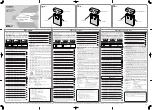
equal to 6mm
2
; this cable must be as short as possible.
Before opening the equipment for the purposes of
adjustment, replacement of components, maintenance or
repairs, it must be disconnected from all sources of electri-
cal power (including mains and battery power). The battery
must only be disconnected after the Start/Stop button has
been set to “0”. Any adjustment, maintenance or repairs to
the equipment while it is open must only be carried out by
an appropriately skilled person who is aware of the risks
involved.
Contact one of the company’s trained technicians if any
problem is encountered when putting the charger into
operation.
Limitations on use
This equipment has been designed for use in a covered
environment. It is only designed to recharge lead/acid
batteries on industrial premises.
Destruction of the equipment
When the equipment becomes obsolete, the casings and the
other internal components can be disposed of by specialist
companies. Local legislation takes precedence over any
instructions in this document and must be scrupulously
observed.
Improvements and modifications
Fiamm Motive Power
®
reserves the right to make any impro-
vements and/or modifications to the product described in
this manual at any time and without prior notice and is not
obliged under any circumstances whatsoever to update the
contents of this manual nor the equipment concerned.
Receipt – Storage
Upon receipt of the package, check for any external or
internal damage and, if necessary, notify the haulier at his
usual premises, by recorded delivery letter, fax or e-mail,
within 24 hours of delivery.
If the charger is to be stored before its use, it must be kept
carefully sealed in its original packaging. It must be stored
in a clean and dry location at a moderate temperature (0°C
to +40°C). Equipment stored at a temperature of less than
15°C must be brought progressively to operating
temperature (over a period of 24 hours) to avoid any risk of
condensation causing electrical faults (particularly
short-circuits).
Replacement parts
The equipment’s production number must be supplied when
ordering any replacement parts. This number can be found
on the information plate.
Information plate
This is located on one side of the charger.
Glossary
The chargers‘ advantages
Fiamm Motive Power chargers are microprocessor-
controlled. The processor calculates the battery’s capacity so
that the charging profile can be automatically adapted to the
battery’s actual state over a wide range of capacities. The
charging coefficient is maintained absolutely on all types of
batteries. Fiamm Motive Power chargers adapt to the
battery’s capacity and its discharge level.
Charging coefficient
The ratio of the number of amp hours restored during
charging to the number of amp hours consumed during
discharge.
Compensation charging
Compensation charging enables the battery to be
maintained at maximum charge all the time that it is
connected to the charger.
Desulphation charging
Desulphation charging, effected before normal charging,
enables the density of batteries that have been heavily
discharged or left a long time without use to be restored.
Equalisation charging
Equalisation charging, effected after normal charging,
balances the densities in the battery’s cells.
Fiamm Motive Power energycom
This unit, permanently mounted on the battery, ensures that
certain battery parameters can be sent to the charger, with
no additional cable required, for the purposes of optimising
the charge and monitoring the charging and discharging
characteristics.
Gel
A sealed battery with gellified electrolyte.
Charging profile
The charging profile defines the rate of current charge over
time. Different charging profiles can be selected, depending
on the type of charger. The charger adapts to the battery’s
age and level of discharge and prolongs its effective life.
Controlling the overcharge coefficient, whatever the
battery’s discharge level, reduces the amount of water
(except for sealed batteries) and electricity consumed.
“Ionic” profile
Also called “ionic mixing”. This type of charging profile
consists of sending short pulses of current to stimulate gas
formation in the active material, causing sulphuric acid to be
distributed outside the plates.
This system of mixing the electrolyte enables more rapid
charging of unsealed batteries subject to very high demands
and balances out differences in density, homogenising the
electrolyte across the surface of the plates.
Gel battery profile
The procedure for charging sealed, maintenance-free
batteries has been optimised to ensure that the particular
conditions required for recharging them are observed. The
main advantages of these batteries are that there is no
necessity to add water, thus reducing maintenance costs,
and no necessity for special charging rooms with ventilation
and water demineralisation units.
Rest function
The Rest function prevents the battery from being dis-
connected for a pre-defined period to ensure a period of
inactivity after charging.
EC declaration of conformity
EnerSys
®
hereby declares that the chargers in the
Premium HF flex range covered by this declaration
conform to the descriptions laid down in European
Directives
Directive 2006/95/EC
(Low Voltage Directive):
EN60950-1
Directive 2004/108/EC
(ElectroMagnetic Compatibility):
EN61000-6-2, EN61000-6-4:Immunity and emissions limits
for industrial electronics (Class A –Industrial Environments)
Directive 2002/95/EC
(RoHS).
4




























